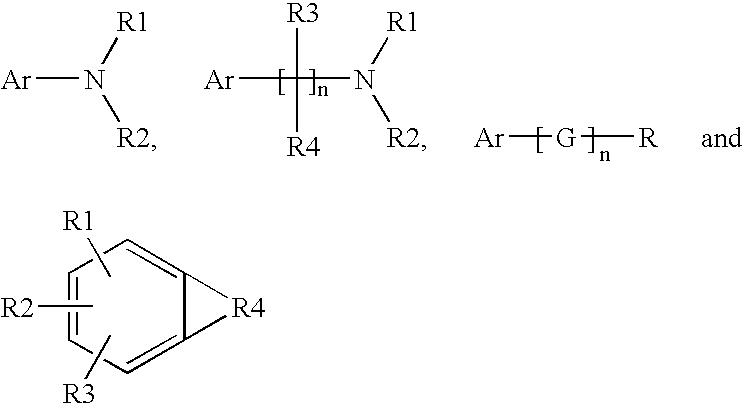Mono-nitration of aromatic compounds via nitrate salts
a technology of aromatic compounds and nitrate salts, which is applied in the preparation of amino compounds, organic chemistry, chemistry apparatus and processes, etc., can solve the problems of high risk of explosion, high risk of side reactions, and high risk of large-scale nitration, so as to avoid the isolation of free base of 5, reduce the burden on process operation, and increase the robustness
- Summary
- Abstract
- Description
- Claims
- Application Information
AI Technical Summary
Benefits of technology
Problems solved by technology
Method used
Image
Examples
example 1
Morpholinoanisole, Nitric Acid Salt (5)
[0029]
[0030]A dry, clean, 1 L, 4-neck round bottom flask, equipped with a mechanic stirrer and a nitrogen inlet, was charged with 20 g (162.3 mMol) of p-anisidine, 48 g (336 mMol) of 2-chloroethyl ether, 1.04 g (3.2 mMol) of tetrabutylammonium bromide, and 77 g of 42% sodium hydroxide solution. The mixture was refluxed at around 110° C. for about 8 h. After confirming the completion of the reaction, the mixture was cooled to 20° C. and extracted with 50 mL TBME and 50 mL ethyl acetate, respectively. The combined organic solution was washed with 80 mL water. The organic solution was cooled to 0±5° C. and to it was slowly added 14.6 g (162.3 mMol) 70% HNO3. A heavy precipitation was formed at the late stage of the addition. After the addition the batch was aged for at least 1 h. The solid was filtered, washed with 40 mL of TBME, and dried under vacuum at 45° C. overnight to give 40.2 g (97%) 5 as a tan solid.
example 2
4-Morpholino-2-nitroanisole (4)
[0031]
[0032]A dry, clean, 250 mL, 4-neck round bottom flask, equipped with a mechanic stirrer and a nitrogen inlet, was charged with 80 g (815 mMol) of 95% sulfuric acid. The acid was cooled to ˜0° C. A solution of 20 g (78 mMol) 5 in 125 mL dichloromethane was slowly added to the acid while maintaining batch temperature at 0±5° C. After the addition the mixture was stirred for 30 minutes. The agitation was stopped and the bottom acid layer was separated. The acid solution was slowly added to 200 mL water while maintaining the temperature at 4OH solution while maintaining the temperature at <10° C. At the end of the addition the pH of the mixture should be higher than 10. The batch was aged at 5±5° C. for 1 h. The solid was filtered, washed with 50 mL water, and dried under vacuum at 45° C. overnight to give 17.5 g (94% yield) of 4 as an orange solid.
example 3
Aniline, Nitric Acid Salt (S-11)
[0033]
[0034]A solution of aniline (10 g, 107 mMol) in 100 mL TBME was cooled to 0±5° C. To this solution was added 70% nitric acid (9.7 g, 107 mMol) while maintaining the temperature at <20° C. After the addition the mixture was agitated at 0±5° C. for approximately 1 h. The solid was filtered, washed with TBME, and dried under house vacuum at ambient temperature overnight to give 16.4 g (98%) of the title compound.
[0035]Compounds S-9, S-12, S-14, S-15, S-16, S-22 were prepared using the same procedure.
PUM
| Property | Measurement | Unit |
|---|---|---|
| Equivalent mass | aaaaa | aaaaa |
| Temperature | aaaaa | aaaaa |
| Temperature | aaaaa | aaaaa |
Abstract
Description
Claims
Application Information
 Login to View More
Login to View More - R&D
- Intellectual Property
- Life Sciences
- Materials
- Tech Scout
- Unparalleled Data Quality
- Higher Quality Content
- 60% Fewer Hallucinations
Browse by: Latest US Patents, China's latest patents, Technical Efficacy Thesaurus, Application Domain, Technology Topic, Popular Technical Reports.
© 2025 PatSnap. All rights reserved.Legal|Privacy policy|Modern Slavery Act Transparency Statement|Sitemap|About US| Contact US: help@patsnap.com



